Tire Size 275/65r18 vs 295/70r18
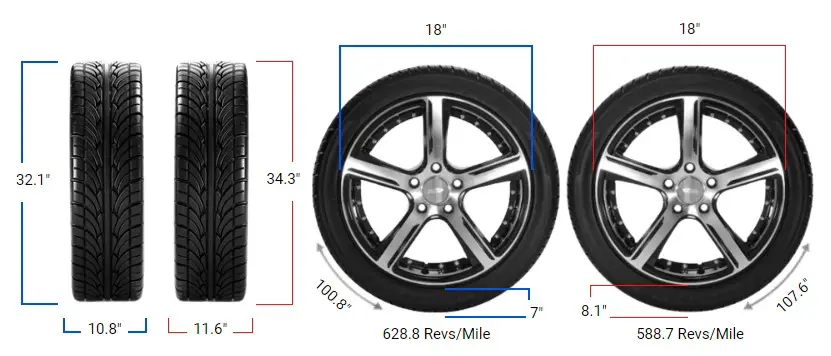
Are you considering upgrading your 275/65R18 tires to a larger 295/70R18 size? While the switch might seem straightforward, it’s crucial to understand the implications before making the change.
- Increased ground clearance improves off-road capability
- Wider tread provides better traction on loose surfaces
- Taller sidewalls may enhance ride comfort by absorbing bumps
- Exceeds recommended 3% diameter difference, may require vehicle modifications
- Potential reduction in fuel economy due to larger size
295/70r18 vs 275/65r18
This table of comparison will assist you in quickly comprehending the disparities.
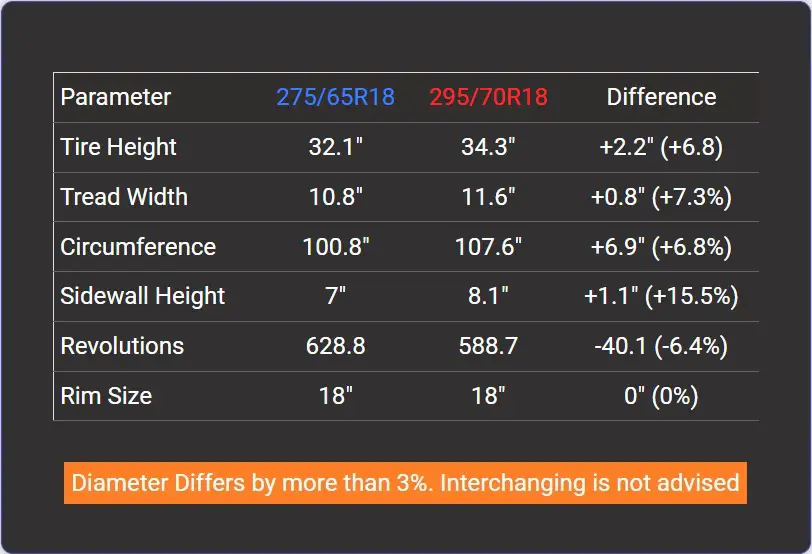
Fitment Guide
Replacement tires should remain within 3% of the original tire’s overall diameter to prevent clearance issues. The 295/70r18 is 6.8% larger in overall diameter than the 275/65r18, exceeding the 3% limit.
To fit 295/70r18 tires without rubbing or scraping, a vehicle may need a minor lift kit or leveling kit installation. Always check carefully for fitment before installing larger tires.
Ground Clearance
With its larger 34.26 inches overall diameter, the 295/70r18 tire provides 1.08 inches more ground clearance than the 275/65r18 32.07-inch diameter.
This added clearance is helpful for off-roading and clearing obstacles or rough terrain without scraping or damaging the undercarriage.
However, the larger diameter 295/70r18 also causes a lower speedometer reading than the 275/65r18.
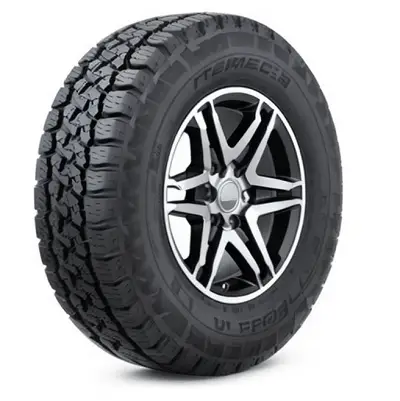
Gas Mileage
The 275/65r18 more minor contact patch and lighter overall weight provide slightly better fuel efficiency over the larger, heavier 295/70r18 tire.
Minimizing rolling resistance helps optimize gas mileage, an important consideration for daily driving.
Ride Comfort
The extra 1.09 inches of sidewall cushioning gives the 295/70r18 tire a modestly smoother ride quality over harsh bumps and uneven pavement.
Its flexible sidewall absorbs more road impacts versus the shorter 275/65r18 sidewall. This difference is subtle but could improve comfort on very rough roads.
Aesthetics
Visually, the difference between 275/65r18 and 295/70r18 tires is minor. The 295/70r18 has a slightly taller sidewall, giving it a subtly “stretched” look compared to the 275/65r18.
For trucks and SUVs, some prefer this taller profile aesthetic over a low-profile appearance.
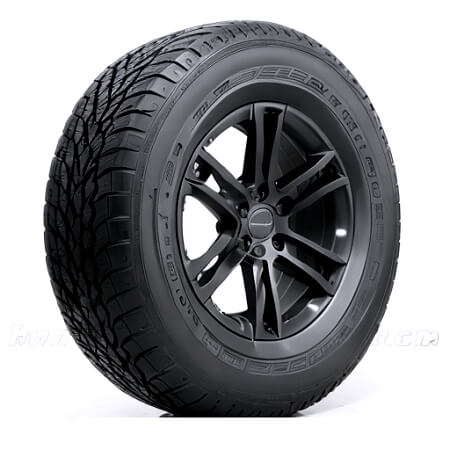
Handling & Stability
The 275/65r18 tire’s shorter, stiffer sidewall provides crisper steering response and handling precision on the pavement.
In contrast, the flexible 295/70r18 sidewall allows more body roll, reducing handling sharpness slightly. However, both tires deliver responsive, stable handling for everyday driving.
Noise & Vibration
With its shorter sidewall, the 275/65r18 transmits more road noise and vibrations into the cabin. The taller 295/70r18 sidewall dampens noise and vibration better. However, both tires deliver a smooth, quiet ride overall.
Durability & Wear
The 275/65r18 smaller contact patch and lighter weight could allow it to exhibit more even treadwear and last slightly longer before needing replacement.
The heavier 295/70r18 applies more stress to suspension and steering components, which may have minor effects on wear over time.
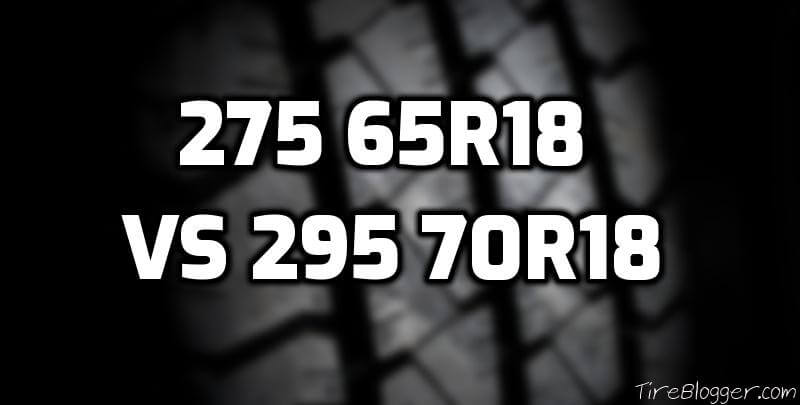
Adverse Conditions
Both tires perform well on wet roads, light snow, and off-road terrain. The 295/70r18 extra ground clearance gives it a slight edge for clearing obstacles, while the 275/65r18 feels a bit more responsive.
But overall, their capabilities are very similar in rain, snow, and off-road conditions.
Speedometer Difference
Due to its larger overall diameter, the 295/70r18 tire causes the speedometer to read higher than the actual speed.
At a speed of 20 mph, the 295/70r18 tire’s speedometer reads 21.36 mph, while the 275/65r18 reads 20 mph. Drivers should be aware of this 1.36 mph speedometer difference.
What Does 275/65r18 Tire Mean?
The 275 65r18 tire size is a bit smaller than the 295 70r18. The “275” refers to the width of the tire in millimeters. The “65” refers to the sidewall height or aspect ratio.
The “r” stands for radial construction, and the “18” refers to the diameter of the wheel in inches. This tire size is often used on SUVs and trucks. It provides a good balance of traction and comfort.
What is the Main Difference Between 275/65r18 and 295/70r18?
The main difference between 275/65r18 and 295/70r18 tires is the overall diameter. The 295/70r18 tires are 2.19 inches (6.8%) taller than the 275/65r18 tires, which exceeds the typically recommended diameter difference of 3% when replacing tires.
Can I Use 295/70r18 Instead of 275/65r18?
While you can physically install 295/70r18 tires in place of 275/65r18, it is not recommended to do so without making necessary modifications.
The 6.8% diameter difference can cause rubbing, clearance issues, speedometer inaccuracy, and changes in vehicle performance.
How Much Taller Is a 295/70r18 Tire Than a 275/65r18?
A 295/70r18 tire is 2.19 inches taller than a 275/65r18 tire, which equates to a 6.8% difference in overall diameter.
This increased height will raise the vehicle’s ground clearance but may negatively impact handling and fuel efficiency.
How Much Wider is a 295/70r18 Tire Than a 275/65r18?
The 295/70r18 tire is 0.79 inches (20 mm) wider than the 275/65r18 tire, representing a 7.3% increase in width.
The wider tread provides a larger contact patch for improved traction, especially in off-road situations, but may slightly affect steering responsiveness.
Our Observations
While switching from 275/65R18 to 295/70R18 tires offers some benefits, particularly for off-road performance, it’s essential to weigh these against the potential drawbacks.
The increased tire size will affect your vehicle’s speedometer accuracy, fuel economy, and on-road handling. However, the difference in ground clearance and traction may be negligible for most drivers.
Ultimately, the decision to switch tire sizes depends on your specific needs and preferences, but it’s crucial to make necessary adaptations to ensure proper fitment and safety.

Meet Caitlin McCormack, a Tire Size Expert and Blogger Passionate About Everything Related to Tires. With Years of Experience in the Tire Industry, Caitlin Has Become an Expert in Tire Sizes and Their Impact on Vehicle Performance.
